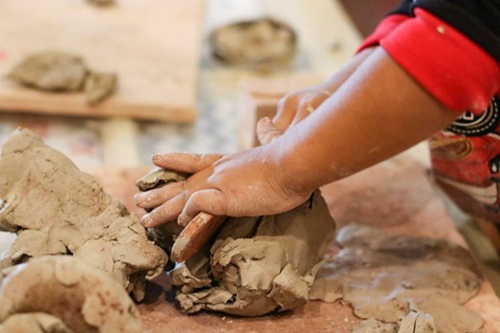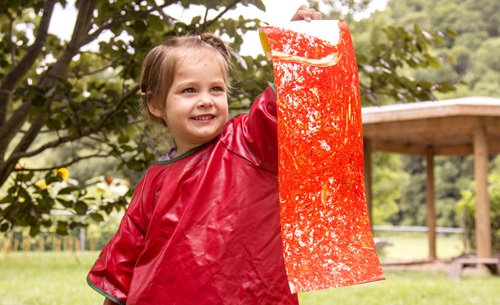Loose Parts for Children with Diverse Abilities
| November 2022When we study the concept of equity and inclusion as it applies to children with diverse abilities, shifting the language from the term “environments” to “ecosystems” may be helpful. This shift in semantics allows us to see that every person, object, and space design is interconnected, each affecting the other. In an inclusive ecosystem, children are not only present but are considered active and valuable members of the family, school, and community. When we approach education from an ecosystem perspective, we begin to value beauty in humans and their surroundings as a catalyst for transforming children’s lives.
Supporting All Children
Early childhood is a significant developmental period for children, including the emergence of new abilities, skills, and capacities in language, physical, psychosocial, and cognitive development. The early childhood ecosystem dramatically influences children’s identity and development. Young children’s earliest years are the foundation for their physical and mental health, emotional security, cultural and personal identity, and developing competencies (United Nations Committee on the Rights of the Child 2005). Children with diverse abilities have the special right to belong to spaces and places where they can thrive and grow as community members. Inclusion is the right children have to actively and fully participate in an educational ecosystem with all their gifts and capacities. Even when a disability is an integral part of who they are, it does not alone define them.
As relationships continue to build and children spend more time playing together, they start to acquire subjective feelings about their distinctiveness from others. They begin to establish a sense of their uniqueness and individuality. Children also start noticing how other people perceive and relate to them. Children with diverse abilities may be sensitive and aware of how people react to their unique characteristics. That is why creating spaces where children of varying abilities are recognized and where they can be in charge of their play and learning is so crucial.
As educators, we must create and design play ecosystems that support children regardless of their ability, race, ethnicity, socioeconomic status, language, family culture, or history. Educators can use a variety of adaptations to increase the participation of children with diverse abilities in the classroom ecosystem. We also need to be cognizant that the accommodations are not excluding children from participating in the natural rhythm of the ecosystem, as they are taken to a separate room to complete assessments or to conduct therapeutic interventions. Instead, we must use a play-as-equity lens as we design inclusive play opportunities. Because of the unscripted value of Loose Parts, children with diverse abilities can discover their own capacities and make sense of the world around them. Loose Parts are materials that entice children of all abilities to explore and engage in sustainable play. Loose Parts can be used in play therapy or to complete required accommodations.
The Power of Loose Parts
Loose Parts support educators in creating inclusive spaces where creative and joyful expression is inspired and where relationships are built through sharing ideas and interests. Loose Parts are non-prescriptive and give complete control and power to children as they use them flexibly. This can be particularly helpful for children with diverse abilities, who manipulate the Loose Parts according to their abilities. Unlike toys, Loose Parts do not come with predetermined directions that measure children’s skills, knowledge, or capabilities. There is no right or wrong way to manipulate and use Loose Parts, so they diminish the possibility of failure and decrease anxiety and frustration. Loose Parts remind us that our focus should be on children’s joy of play rather than assessing skills and striving for mastery or promoting corrective measures. Children with diverse abilities want nothing more than to be accepted and have a sense of belonging.
Loose Parts help children express who they are and how they perceive themselves as they use them in their play, to make connections, communicate their ideas and build relationships. Children with diverse abilities can create their own tempo while playing with the Loose Parts without feeling pressured to produce a product or achieve a prescribed result. Beautiful Loose Parts invite children to look closely, notice details and think about how they will use them to express their ideas. In other words, Loose Parts invite children to slow down, take their time and participate in something bigger than themselves.
Loose Parts play is that active, joyful way children choose to spend their time when they are not directed by adults. It is also how children, regardless of their ability or background, connect with one another. For example, Simone, who exhibits neurodiversity, finds playful ways to invite other children to play with her. On one occasion, Simone observes Jayme and Charlotte setting the table with cups, saucers, and tiny colorful wood beads for a tea party. She approaches the space, touches Jayme’s shoulder, smiles, and points to herself. Charlotte approaches Simone and says, “Yes, Simone, you can come to our tea party and taste the macaroons.” Simone has developed a system of communication that other children understand. Simone takes some wooden chips and puts them on a plate as the tea party continues. She points to them, picks one up, and brings her “macaroon” to her mouth, pretending to eat it. Jayme says, “Thank you for the delicious cookies.” For Simone, communication happens through body language—she is incredibly skilled when she engages in play that is meaningful to her.
Children who play with Loose Parts inhabit the fertile world between actuality and possibility. They incorporate what may be part of their imagination—such as being a fairy that changes people’s lives or using Loose Parts to create fantasy lands that grow and change to accommodate their ideas. Loose Parts Play supports their creative process. Children with diverse abilities may take longer to complete a play sequence, and it must be regarded as a mark of strength, not a delay caused by their disability.
An Invitation to Explore
To create more inclusive ecosystems requires educators to explore Loose Parts and to take a risk by suspending their previous conceptions of how children learn. Educators must play with Loose Parts, explore them, and create with them until the materials feel less risky and their value becomes apparent. I invite you, the reader, to find yourself feeling inspired or curious about your unexpected discoveries. When we observe how children play with Loose Parts, we find that they not only relax but also become more open to new experiences and change.
Article based on excerpts from Chapter 1: Beloglovsky, Miriam. 2022. Loose Parts for Children with Diverse Abilities. Minnesota: Redleaf Press.
Read the book!
Copyright ©Redleaf Press. Reprinted with permission. All rights reserved. Visit us
Follow Miriam's work at playfultransformation.com












